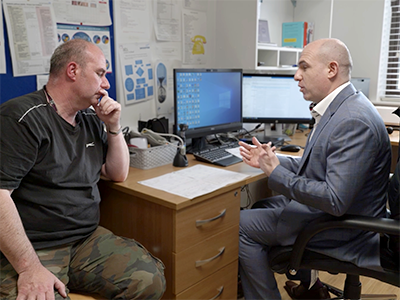Evaluating ADHD in primary care – objectively

1-minute summary: This case study shares the story of how the Sunlight Group Practice in the Wirral, Merseyside, is the first in the country to combine secondary care specialist services with primary care in ADHD to deliver an integrated, efficient pathway.
About the Leap Project
The Leap Project is the first service in England to combine secondary care specialist services with primary care to deliver an integrated, efficient pathway. The project involved the Wirral CCG (clinical commissioning group), the Wirral adult ADHD team at the Sunlight Group Practice (part of the Cheshire and Wirral Partnership NHS Foundation Trust), and Qbtech.
Currently, there are national challenges with access to adult ADHD services which means practices can be overwhelmed with the amount of referrals they receive. Typically, patients can expect to spend several years on a waiting list to find out whether they have ADHD or not.
The aim of the Leap Project was to improve clinical efficiency for less complex cases where adult ADHD was the primary concern – in other words, patients without any additional serious mental health concerns.
The challenge before QbTest’s introduction
In the past, GPs in the Wirral would refer patients suspected of having ADHD to secondary care, where they could face a lengthy wait for an assessment. Subsequently, the Leap review service was established, offering a primary care ADHD review clinic. GPs underwent training to assess ADHD, transferring patients from secondary care to primary care, which helped relieve waiting lists.
Now, with the integration of QbTest, the ADHD assessment and treatment process has been accelerated, leading to faster treatment for patients compared to the previous pathways.
Following the project which assessed 48 patients, QbTest has now been rolled out across other primary care networks, with GPs and mental health workers across these organisations being trained on how to administer the tests and interpret the results. Moving the assessment into primary care allows patients to be assessed in primary care after a referral.
“The fact we can manage entirely within primary care and will never have to touch on the very precious secondary care service other than clinical oversight. I think that’s probably what gives it, in essence, the ability to cut down on waiting times.”
– Darren Birks, Senior Partnerships and Transformation Manager – Mental Health NHS Cheshire and Merseyside
Outcomes for patients: helping patients understand their ADHD symptoms
The Leap Project pilot demonstrated that there was improved patient experience and clinical efficiency by reducing the number of appointments needed to diagnose or rule out ADHD. Since the project, other primary care networks across the area will be trained in how to use QbTest. This allows low-risk patients to be assessed and given results in one visit to their GP whilst relieving secondary care services from an overwhelming number of referrals.
“I didn’t particularly think it was ADHD, I just thought the rest of the world were looking at things differently to me.
“51, to find out that, and I could’ve been sorted out anywhere from the age of six if they’d have spotted that earlier on in my life. I have good friends of mine from school who look after my bank accounts for me now, and they tell me off when I’ve been spending too much. My bank accounts were just absolutely horrendous. I was paying interest, after interest, after interest, and basically not eating.”
– Greg Archer, a patient at Sunlight Group Practice
Improving clinical practice through dedicated support
When practices introduce QbTest into their ADHD pathway, they get:
- Comprehensive and ongoing training to ensure a standardized test environment
- Access to a clinical advisor team from the outset who provide consultations on specific reports as needed
- Annual refresher training for up-to-date knowledge on research and new features of QbTest
“There’s a trained administrator here who can do QbTest and puts patients in a relaxing environment to make sure they’re comfortable and they understand what the test is. When I see the patients straight afterward when they’ve had QbTest I can go through those results with them and give them a visual image of what their symptoms are displaying on the screen and how it meets the symptoms of ADHD.
“It’s that instant feedback that they get, and they find it rewarding in terms of seeing that potentially they are different, and this is explaining why.”
– Dr. Chris Pritchard
The AHSN Network has supported the national rollout of QbTest across England
Since 2020, the AHSNs have been assisting in the nationwide implementation of QbTest in clinics throughout England. This initiative, known as Focus ADHD, is sponsored by NHS England and aims to improve the evaluation of ADHD in children and young individuals.
By incorporating QbTest into the assessment process, alongside rating scales and clinical interviews, clinicians get a comprehensive understanding of patient history, enabling them to make well-informed diagnostic decisions.
Not only has this improved the quality of care given to patients during ADHD assessments, but also minimizes the number of appointments required to reach a diagnostic conclusion.
The success of this project has been the result of collaboration between the Cheshire and Wirral Partnership NHS Foundation Trust and Qbtech. Working with the trust, our experts helped them review their pathway and identify opportunities for incorporating objective data with QbTest and helped them to streamline their ADHD pathway.
Jo Barosa, Account Director at Qbtech
Jo Barosa has over 20 years of experience working in the ADHD landscape, working to improve outcomes for children and adults by driving ADHD pathway innovation and supporting services in best practices.
As the operational lead for the National Programme (Focus ADHD) and working collaboratively with the Academic Health Science Networks (AHSN) and NHS services, she is proud to have played a part, alongside colleagues, in improving access to objective testing as part of a quality improvement initiative.
 “It’s a fantastic collaboration between primary care and secondary care in a specialist service – the adult service…just to open up that access for patients. Waiting lists nationally are very, very big…I think what has happened with the Leap Project is exceptional. It’s the first one in the country.”
“It’s a fantastic collaboration between primary care and secondary care in a specialist service – the adult service…just to open up that access for patients. Waiting lists nationally are very, very big…I think what has happened with the Leap Project is exceptional. It’s the first one in the country.”
– Jo Barosa
Contact us to speak directly with one of our experts like Jo on how Qbtech can optimize your care pathway and deliver patients the services they deserve.

Discover more about the benefits of QbTest with our case studies including improved clinical efficiency in Dutch ADHD evaluations and reducing wait times with the Greenwich ADHD team.
Speak with our experts for an ADHD pathway consultation
Read more of our case studies, such as the importance of patient-centred care and objective testing. You can also learn more about a recent report by the National Institute for Clinical Excellence (NICE), which has recognized QbTest as a technology that gives clinicians greater confidence in diagnoses, saves time, and makes the ADHD pathway more efficient.

